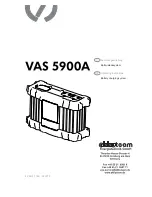
INSTRUCTION / TROUBLESHOOTING MANUAL FOR MODEL A75MD
PAGE 6 OF 22
The "Fault" lamp will light and the VFD will display "Phase 1 Override Timer".
5. Phase 2 Override Timer - If the charge curve does not reach Phase 3 / Finish Rate stage within
appropriate time limit (default – 3 hours), Phase 2 override timer will occur and terminate the charge.
The "Fault" lamp will light and the VFD will display "Phase 2 Override Timer".
6. di/dt Charge Shutoff – If the battery current in Phase 2 / Constant Voltage stage does not fall or starts
to increase the charger will shutoff with di/dt fault. The "Fault" lamp will light and the VFD will display
"DIDT".
7. System Reset - Push and hold the STOP pushbutton until the “Fault” lamp illuminates solid red, then
release the STOP pushbutton. The unit will reset and the lamp test will blink all lamps and after a
short delay the “Fault” lamp will switch from solid to blinking as part of the lamp test. System reset
may only be performed if the battery is connected.
* "Standard Charge” Lamp
This (LED) indicator will light when the charger is operating in the Standard Charge mode. This means that the
charger may run up to 3 hours after reaching the finish rate depending on the condition of the battery.
* "Equalize” Lamp
This (LED) will light when the charger is operating in the Equalize mode. This means that the charger may run
up to 6 hours after the finish rate is reached depending on the condition of the battery. See battery manual for
recommended equalize practices.
THEORY OF OPERATION
It is recommended that the connector used for the battery/charger connection have an auxiliary control
contact. (A contact that makes last and breaks first.) This contact should be wired to the battery positive on
the battery side of the connector and to Pin #2 of the terminal strip on the charger side of the connector. (The
jumper bar between Pins 1 and 2 must be removed when using the auxiliary control contact.)
The charger provides automatic AC input line compensation. The automatic compensation eliminates charging
problems that arise from a varying input line when charging continually or for two or three shift operations.
The unit is self-protecting when subjected to abnormal overloading conditions.
It should not be necessary to make any adjustments to this charger. Because of the stability of design, the unit
needs no periodic adjustment. This, along with the rugged construction and conservatively rated components,
insures long life and trouble-free operation.
Should any adjustments be necessary, a factory service representative should be contacted.
After the START pushbutton is pushed, the charger senses the connection of the battery and determines if it is
in the proper range, 1.75 volts per cell to 2.5 volts per cell, and then slowly ramps the output current up to
start the charge. The "Ramp Up" lamp will be lit during this stage. When the start rate is reached, the "Start
Rate" lamp illuminates. If a fully charged battery is connected, the charger will charge for 15 minutes and then
turn off. The VFD will alternate between "Fully Charged Battery", "Elapsed Time" and "AH Returned".
When the 80% point (2.42 volts per cell) is reached, the charger will enter the constant voltage stage and the
"Constant Voltage" lamp will illuminate. The voltage will stay constant as the current decreases. Di/dt
monitoring will start. If the battery current stops decreasing in the constant voltage stage and never reaches
the finish rate the charger will be shutoff with DIDT fault.
When the current reaches the finish rate, the "Finish Rate" lamp illuminates and the protection timer starts. 3-
hr timer for standard charge and 6-hr timer for equalize charge. Dv/dt monitoring will start and terminate the
charge once the battery voltage levels. If the battery voltage keeps increasing and never levels the protection
timers will terminate the charge.
When a charging cycle is completed correctly, the "Charger On" lamp will turn off. The VFD will cycle through
"Amp-Hour Returned", "Elapsed Time" and "Cooling Time". (Refer to flow chart on page 18)
If the discharged battery is not the correct number of cells or if the correct battery is over discharged the unit







































